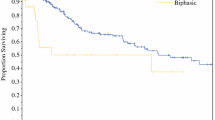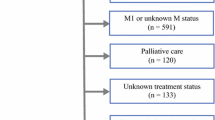Abstract
Purpose
Diffuse malignant peritoneal mesothelioma (DMPM) is a rare primary peritoneal malignancy. Its prognosis has been improved by an aggressive locoregional treatment combining extensive cytoreductive surgery (CRS) and hyperthermic intraperitoneal chemotherapy (HIPEC). Prognostic factors are currently poorly defined for this disease but are essential if treatment is to be standardized.
Methods
Twenty-eight patients with DMPM, who were considered preoperatively to be candidates for CRS and HIPEC between June 1998 and August 2010 at our institution, were selected for this study. Medical records and histopathological features were retrospectively reviewed and 24 clinical, histological, and immunohistochemical parameters were assessed for their association with overall survival by univariate and multivariate analyses.
Results
The following factors were significantly associated with overall survival by univariate analysis: predominant histological growth pattern in the epithelioid areas, nuclear grooves in the epithelioid areas, atypical mitoses, and calretinin and GLUT1 expression by immunohistochemistry in the epithelioid areas. Expression of the facilitative glucose transporter protein GLUT1 in the epithelioid areas was the only factor independently associated with overall survival by multivariate analysis.
Conclusions
GLUT1 expression appears to be an indicator of poor prognosis in DMPM. Standard histological classification of DMPM may not be adequate to select patients for aggressive locoregional treatments, such as CRS and HIPEC. Multicenter validation of the prognostic factors identified in this preliminary study is needed to refine patient selection for potential cure.

Similar content being viewed by others
References
Sebbag G, Yan H, Shmookler BM, Chang D, Sugarbaker PH. Results of treatment of 33 patients with peritoneal mesothelioma. Br J Surg. 2000;87:1587-93.
Yan TD, Welch L, Black D, Sugarbaker PH. A systematic review on the efficacy of cytoreductive surgery combined with perioperative intraperitoneal chemotherapy for diffuse malignancy peritoneal mesothelioma. Ann Oncol. 2007;18:827-34.
Acherman YI, Welch LS, Bromley CM, Sugarbaker PH. Clinical presentation of peritoneal mesothelioma. Tumori. 2003;89:269-73.
Baratti D, Kusamura S, Cabras AD, Laterza B, Balestra MR, Deraco M. Lymph node metastases in diffuse malignant peritoneal mesothelioma. Ann Surg Oncol. 2010;17:45-53.
Brigand C, Monneuse O, Mohamed F, Sayag-Beaujard AC, Isaac S, Gilly FN, Glehen O. Peritoneal mesothelioma treated by cytoreductive surgery and intraperitoneal hyperthermic chemotherapy: results of a prospective study. Ann Surg Oncol. 2006;13:405-12.
Deraco M, Nonaka D, Baratti D, et al. Prognostic analysis of clinicopathologic factors in 49 patients with diffuse malignant peritoneal mesothelioma treated with cytoreductive surgery and intraperitoneal hyperthermic perfusion. Ann Surg Oncol. 2006;13:229-37.
Elias D, Bedard V, Bouzid T, Duvillard P, Kohneh-Sharhi N, Raynard B, Goere D. Malignant peritoneal mesothelioma: treatment with maximal cytoreductive surgery plus intraperitoneal chemotherapy. Gastroenterol Clin Biol. 2007;31:784-8.
Feldman AL, Libutti SK, Pingpank JF, et al. Analysis of factors associated with outcome in patients with malignant peritoneal mesothelioma undergoing surgical debulking and intraperitoneal chemotherapy. J Clin Oncol. 2003;21:4560-7.
Hesdorffer ME, Chabot JA, Keohan ML, et al. Combined resection, intraperitoneal chemotherapy, and whole abdominal radiation for the treatment of malignant peritoneal mesothelioma. Am J Clin Oncol. 2008;31:49-54.
Kluger MD, Taub RN, Hesdorffer M, Jin Z, Chabot JA. Two-stage operative cytoreduction and intraperitoneal chemotherapy for diffuse malignant peritoneal mesothelioma: operative morbidity and mortality in phase I and II trials. Eur J Surg Oncol. 2010;36:997-1003.
Passot G, Cotte E, Brigand C, Beaujard AC, Isaac S, Gilly FN, Glehen O. Peritoneal mesothelioma: treatment with cytoreductive surgery combined with hyperthermic intraperitoneal chemotherapy. J Chir. 2008;145:447-53.
Sugarbaker PH, Welch LS, Mohamed F, Glehen O. A review of peritoneal mesothelioma at the Washington Cancer Institute. Surg Oncol Clin N Am. 2003;12:605-21.
Yan TD, Popa E, Brun EA, Cerruto CA, Sugarbaker PH. Sex difference in diffuse malignant peritoneal mesothelioma. Br J Surg. 2006;93:1536-42.
Yan TD, Yoo D, Sugarbaker PH. Significance of lymph node metastasis in patients with diffuse malignant peritoneal mesothelioma. Eur J Surg Oncol. 2006;32:948-53.
Blackham AU, Shen P, Stewart JH, Russell GB, Levine EA. Cytoreductive surgery with intraperitoneal hyperthermic chemotherapy for malignant peritoneal mesothelioma: mitomycin versus cisplatin. Ann Surg Oncol. 2010;17:2720-7.
Chua TC, Yan TD, Morris DL. Outcomes of cytoreductive surgery and hyperthermic intraperitoneal chemotherapy for peritoneal mesothelioma: the Australian experience. J Surg Oncol. 2009;99:109-13.
Chua TC, Yao P, Akther J, Morris DL. Impact of tumor angiogenesis in peritoneal mesothelioma after radical cytoreduction and hyperthermic intraperitoneal chemotherapy. Pathol Oncol Res. 2010;16:217-22.
Loggie BW, Fleming RA, McQuellon RP, Russell GB, Geisinger KR, Levine EA. Prospective trial for the treatment of malignant peritoneal mesothelioma. Am Surg. 2001;67:999-1003.
Yan TD, Deraco M, Baratti D, et al. Cytoreductive surgery and hyperthermic intraperitoneal chemotherapy for malignant peritoneal mesothelioma: multi-institutional experience. J Clin Oncol. 2009;27:6237-42.
Yan TD, Deraco M, Elias D, et al. A novel tumor-node-metastasis (TNM) staging system of diffuse malignant peritoneal mesothelioma using outcome analysis of a multi-institutional database. Cancer. 2011;117:1855-63.
Yan TD, Edwards G, Alderman R, Marquardt CE, Sugarbaker PH. Morbidity and mortality assessment of cytoreductive surgery and perioperative intraperitoneal chemotherapy for diffuse malignant peritoneal mesothelioma: a prospective study of 70 consecutive cases. Ann Surg Oncol. 2007;14:515-25.
Baratti D, Kusamura S, Cabras AD, Dileo P, Laterza B, Deraco M. Diffuse malignant peritoneal mesothelioma: failure analysis following cytoreduction and hyperthermic intraperitoneal chemotherapy (HIPEC). Ann Surg Oncol. 2009;16:463-72.
Borczuk AC, Taub RN, Hesdorffer M, et al. P16 loss and mitotic activity predict poor survival in patients with peritoneal malignant mesothelioma. Clin Cancer Res. 2005;11:3303-8.
Cerruto CA, Brun EA, Chang D, Sugarbaker PH. Prognostic significance of histomorphologic parameters in diffuse malignant peritoneal mesothelioma. Arch Pathol Lab Med. 2006;130:1654-61.
Nonaka D, Kusamura S, Baratti D, et al. Diffuse malignant mesothelioma of the peritoneum: a clinicopathological study of 35 patients treated locoregionally at a single institution. Cancer. 2005;104:2181-8.
Krasinskas AM, Bartlett DL, Cieply K, Dacic S. CDKN2A and MTAP deletions in peritoneal mesotheliomas are correlated with loss of p16 protein expression and poor survival. Mod Pathol. 2010;23:531-8.
Yan TD, Brun EA, Cerruto CA, Haveric N, Chang D, Sugarbaker PH. Prognostic indicators for patients undergoing cytoreductive surgery and perioperative intraperitoneal chemotherapy for diffuse malignant peritoneal mesothelioma. Ann Surg Oncol. 2007;14:41-9.
Acurio A, Arif Q, Gattuso P, McIntere M, Krausz T, Husain AN. Value of immunohistochemical markers in differentiating benign from malignant mesothelial lesion. Mod Pathol. 2008;21:334A.
Kato Y, Tsuta K, Seki K, et al. Immunohistochemical detection of GLUT-1 can discriminate between reactive mesothelium and malignant mesothelioma. Mod Pathol. 2007;20:215-20.
Lagana SM, Taub RN, Borczuk AC. Utility of glucose transporter 1 in the distinction of benign and malignant thoracic and abdominal mesothelial lesions. Arch Pathol Lab Med 2012;136:804-9.
Monaco SE, Shuai Y, Bansal M, Krasinskas AM, Dacic S. The diagnostic utility of p16 FISH and GLUT-1 immunohistochemical analysis in mesothelial proliferations. Am J Clin Pathol. 2011;135:619-27.
Cantuaria G, Fagotti A, Ferrandina G, et al. GLUT-1 expression in ovarian carcinoma: association with survival and response to chemotherapy. Cancer. 2001;92:1144-50.
Fenske W, Volker HU, Adam P, et al. Glucose transporter GLUT1 expression is an stage-independent predictor of clinical outcome in adrenocortical carcinoma. Endocr Relat Cancer. 2009;16:919-28.
Haber RS, Rathan A, Weiser KR, et al. GLUT1 glucose transporter expression in colorectal carcinoma: a marker for poor prognosis. Cancer. 1998;83:34-40.
Kawamura T, Kusakabe T, Sugino T, et al. Expression of glucose transporter-1 in human gastric carcinoma: association with tumor aggressiveness, metastasis, and patient survival. Cancer. 2001;92:634-41.
Legan M, Tevzic S, Tolar A, Luzar B, Marolt VF. Glucose transporter-1 (GLUT-1) immunoreactivity in benign, premalignant and malignant lesions of the gallbladder. Pathol Oncol Res. 2011;17:61-6.
Mori Y, Tsukinoki K, Yasuda M, Miyazawa M, Kaneko A, Watanabe Y. Glucose transporter type 1 expression are associated with poor prognosis in patients with salivary gland tumors. Oral Oncol. 2007;43:563-9.
Ozbudak IH, Shilo K, Tavora F, et al. Glucose transporter-1 in pulmonary neuroendocrine carcinomas: expression and survival analysis. Mod Pathol. 2009;22:633-8.
Sung JY, Kim GY, Lim SJ, Park YK, Kim YW. Expression of the GLUT1 glucose transporter and p53 in carcinomas of the pancreatobiliary tract. Pathol Res Pract. 2010;206:24-9.
Kao SC, Klebe S, Henderson DW, et al. Low calretinin expression and high neutrophil-to-lymphocyte ratio are poor prognostic factors in patients with malignant mesothelioma undergoing extrapleural pneumonectomy. J Thorac Oncol. 2012;6:1923-9.
Kleinberg L, Lie AK, Florenes VA, Nesland JM, Davidson B. Expression of inhibitor-of-apoptosis protein family members in malignant mesothelioma. Hum Pathol. 2007;38:986-94.
Zaffaroni N, Costa A, Pennati M, et al. Survivin is highly expressed and promotes cell survival in malignant peritoneal mesothelioma. Cell Oncol. 2007;29:453-66.
Sugarbaker PH. Peritonectomy procedures. Ann Surg. 1995;221:29-42.
Gilly FN, Carry PY, Sayag AC, et al. Regional chemotherapy (with mitomycin C) and intra-operative hyperthermia for digestive cancers with peritoneal carcinomatosis. Hepatogastroenterology. 1994;41:124-9.
Jacquet P, Sugarbaker PH. Clinical research methodologies in diagnosis and staging of patients with peritoneal carcinomatosis. Cancer Treat Res. 1996;82:359-74.
Travis WD, Brambilla E, Müller-Hermelink HK, Harris CC. World Health Organization Classification of Tumors: pathology and genetics of tumors of the lung, pleura, thymus and heart. 3rd ed. Lyon: IARC Press; 2004.
Benjamini Y, Yekutieli D. The control of the false discovery rate in multiple testing under dependency. Ann Stat. 2001;29:1165-88.
Antman KH, Osteen RT, Klegar KL, Amato DA, Pomfret EA, Larson DA, Corson JM. Early peritoneal mesothelioma: a treatable malignancy. Lancet. 1985;2:977-81.
Kerrigan SA, Turnnir RT, Clement PB, Young RH, Churg A. Diffuse malignant epithelial mesotheliomas of the peritoneum in women: a clinicopathologic study of 25 patients. Cancer. 2002;94:378-85.
Macheda ML, Rogers S, Best JD. Molecular and cellular regulation of glucose transporter (GLUT) proteins in cancer. J Cell Physiol. 2005;202:654-62.
Kaira K, Serizawa M, Koh Y, et al. Relationship between (18)F-FDG uptake on positron emission tomography and molecular biology in malignant pleural mesothelioma. Eur J Cancer. 2012;48:1244-54.
Acknowledgment
The study was supported by RENAPE (Centre National de Référence des Tumeurs Rares du Péritoine) depending on INCa (Institut National du Cancer) for the purchase of some antibodies. The authors thank Béatrice Bancel and Céline Michaux for their contribution to laboratory technique, the ARCs Laurent Villeneuve, Isabelle Bonnefoy, Peggy Jourdan-Enfer and Emilie Mathiotte for their help with the clinical database, and Christelle Maurice for her contribution to statistical analysis.
Disclosure
The authors indicate no potential conflict of interest.
Author information
Authors and Affiliations
Corresponding author
Rights and permissions
About this article
Cite this article
Hommell-Fontaine, J., Isaac, S., Passot, G. et al. Malignant Peritoneal Mesothelioma Treated by Cytoreductive Surgery and Hyperthermic Intraperitoneal Chemotherapy: Is GLUT1 Expression a Major Prognostic Factor? A Preliminary Study. Ann Surg Oncol 20, 3892–3898 (2013). https://doi.org/10.1245/s10434-013-3077-4
Received:
Published:
Issue Date:
DOI: https://doi.org/10.1245/s10434-013-3077-4




